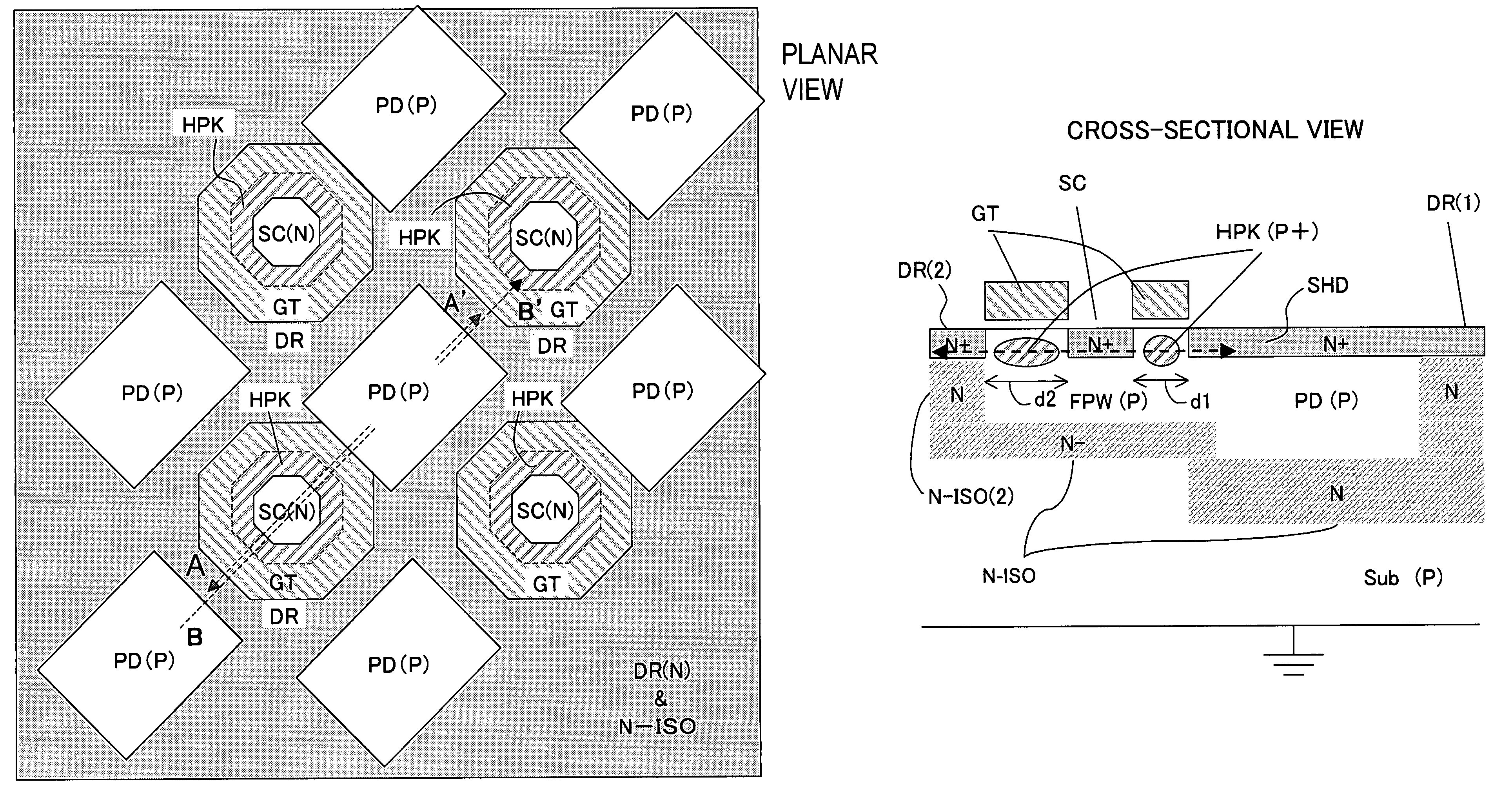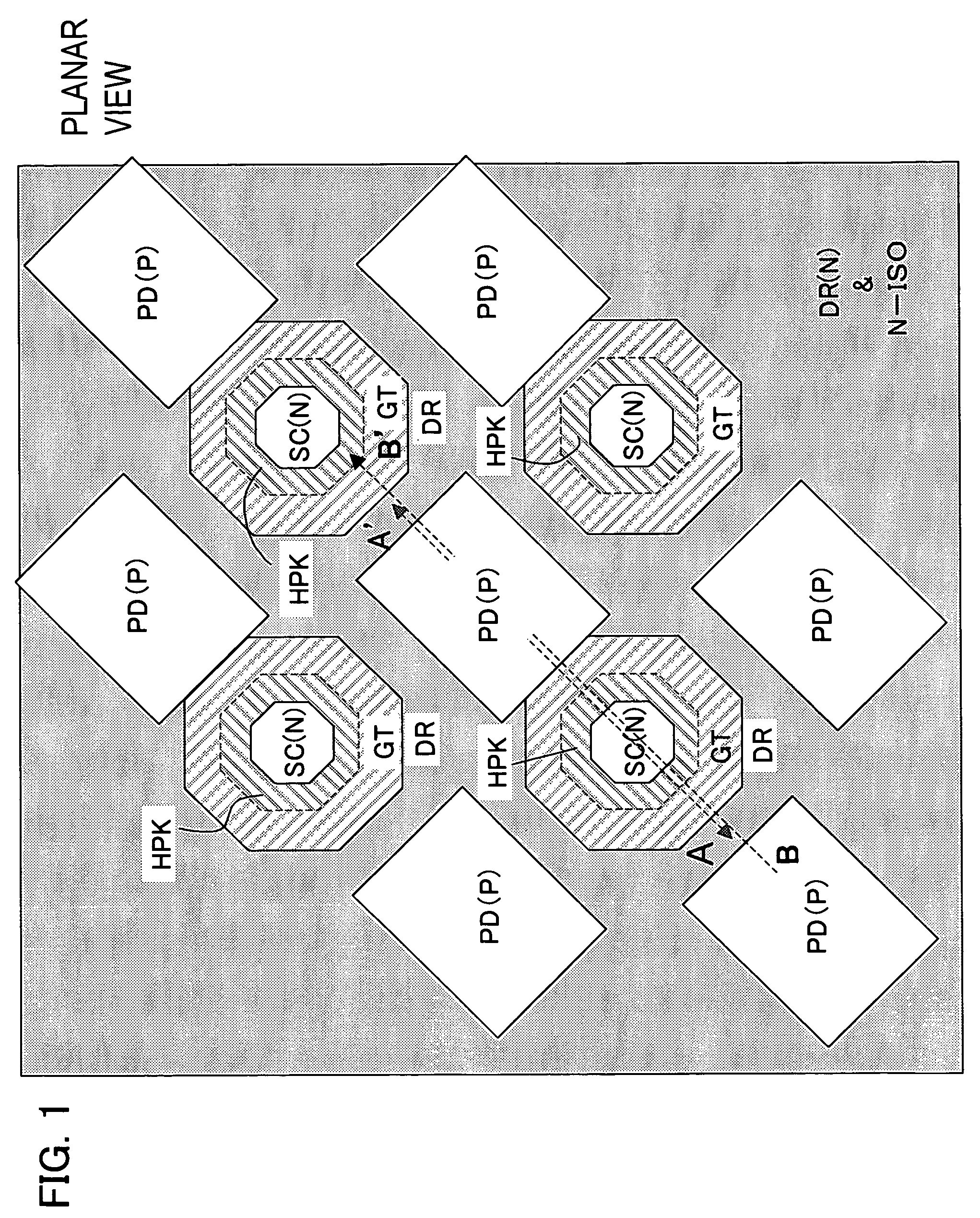Threshold voltage modulation image sensor
a technology of threshold voltage and image sensor, which is applied in the field of threshold voltage (vth) modulation image sensor, can solve the problems of complex pixel structure of ccd image sensor, difficult to integrate ccd image sensor in the same chip as that of peripheral signal processing circuit, and require a process, so as to achieve the effect of increasing light sensitivity and miniaturizing the pixel region
- Summary
- Abstract
- Description
- Claims
- Application Information
AI Technical Summary
Benefits of technology
Problems solved by technology
Method used
Image
Examples
first embodiment
[0064]FIG. 5 shows a cross-sectional view and a hole potential diagram of an image sensor of a The planar shape of the image sensor of this embodiment is as per FIG. 3A, but, this planar shape is different in that the width of the gate electrode GT is narrower on the side of the photoelectric conversion region PD. That is, as illustrated by the cross-sectional view in FIG. 5A, the gate width of the gate electrode GT is narrower in part d1 close to the photoelectric conversion region PD than in part d2 outside the photoelectric conversion region PD. Further, a high-density P-type potential pocket region HPK is formed over the whole surface of the floating P-type well region FPW below the gate electrode GT. For this reason, the width d1 of the PD-side potential pocket region HPK(PD) is then narrower than the width d2 of the potential pocket region HPK(Non-PD) on the side of the N-type isolation region N-ISO (2) in the substrate. However, because the potential pocket region HPK is not...
second embodiment
[0066]FIG. 6 provides a cross-sectional view and a hole potential diagram of the image sensor of the In this example, the widths d1 and d2 of the ring-like gate electrode GT are substantially constant or equal and the width of the potential pocket region HPK is substantially constant or equal. However, the P-type impurity concentration of the PD-side potential pocket region HPK (P+) is made lower than the P-type impurity concentration of the potential pocket region HPK (P++) that is adjacent to the N-type isolation region N-ISO(2) in the substrate outside the PD region. As per the planar and cross-sectional views, the pocket region HPK is such that the PD-side region is P+ (high-density P-type region) and the remaining region is P++ (a higher density P-type region). Thus, by providing such a difference in density, the potential depth of the PD-side pocket region can be made shallow and the potential non-uniformity with respect to the pocket region HPK close to the isolation region ...
third embodiment
[0068]FIG. 7 provides a cross-sectional view and a hole potential diagram of the image sensor of the So too with this example, the widths d1 and d2 of the ring-like gate electrode GT are substantially constant and the width of the potential pocket region HPK is substantially constant. In addition, the impurity concentration is also substantially constant. However, an offset structure OFFSET that spaces the N-type isolation region N-ISO provided in the substrate apart from the gate electrode near the gate electrode GT is provided. That is, the planar view of FIG. 7A illustrates the relationship between the N-type isolation region N-ISO formed in the substrate and the gate electrode GT and photoelectric conversion region PD. However, the N-type isolation region N-ISO is formed with an offset OFFSET in the region of the gate electrode GT that is not adjacent to the photodiode PD. That is, as indicated by the arrow 10 in the cross-sectional view of FIG. 7B, the N-type isolation region ...
PUM
 Login to View More
Login to View More Abstract
Description
Claims
Application Information
 Login to View More
Login to View More - R&D
- Intellectual Property
- Life Sciences
- Materials
- Tech Scout
- Unparalleled Data Quality
- Higher Quality Content
- 60% Fewer Hallucinations
Browse by: Latest US Patents, China's latest patents, Technical Efficacy Thesaurus, Application Domain, Technology Topic, Popular Technical Reports.
© 2025 PatSnap. All rights reserved.Legal|Privacy policy|Modern Slavery Act Transparency Statement|Sitemap|About US| Contact US: help@patsnap.com



